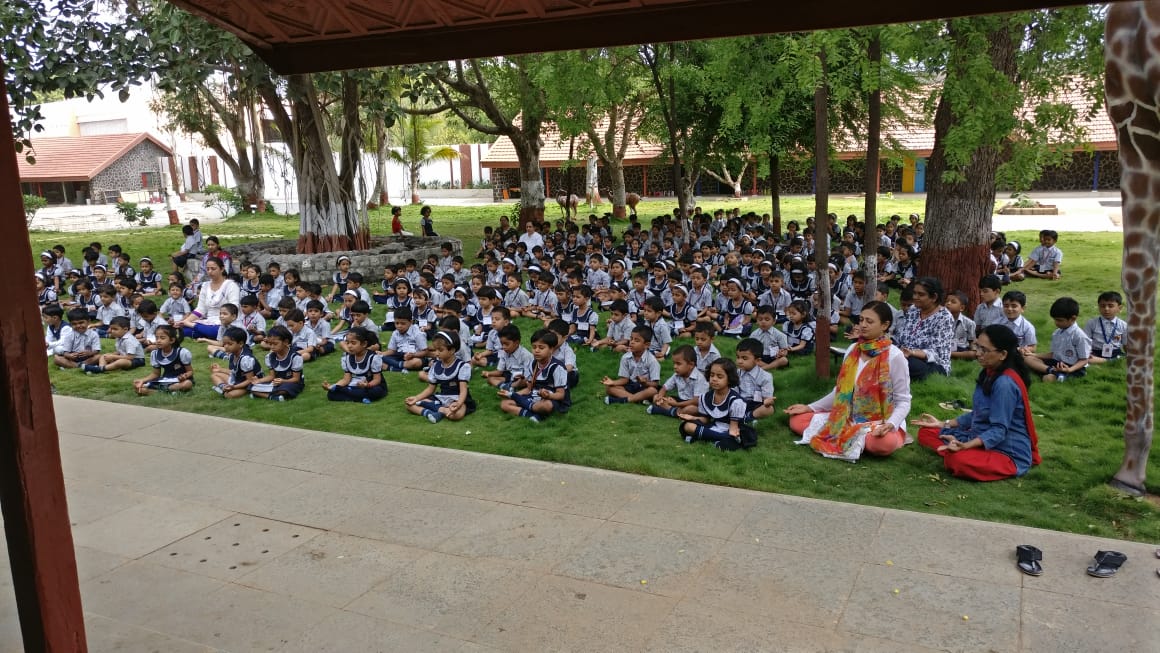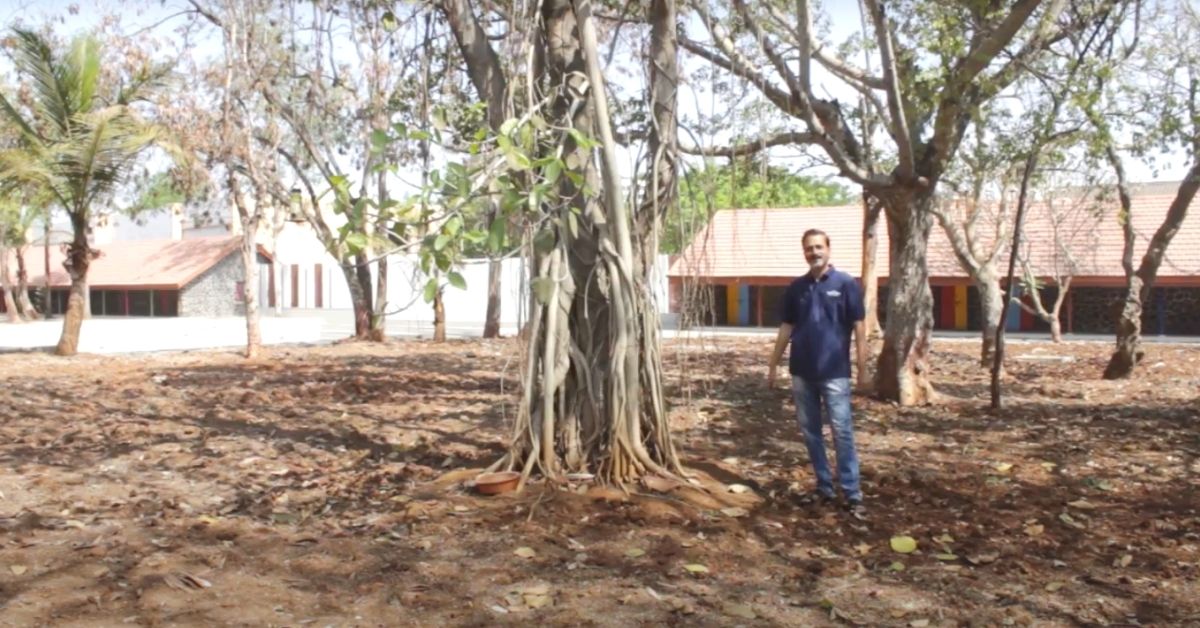Architect Revives 100-Year-Old Nashik School Without Cutting a Single Tree
Dhananjay Shinde, a city-based architect restored the 100-year-old Udoji boarding school in Nashik with a green touch

“There is no school in the city which has 100 trees and a large playground. The temperature in the school is always cooler than the surrounding areas in the city,” says Deepti Patel, principal of Udoji pre-primary school.
Located in Nashik, Maharashtra, this century-old dilapidated structure recently got a new lease of life, after it was restored to its original glory, along with a host of environmentally friendly features.
Deepti says, “We have children hanging to the roots of a banyan tree, or doing activities under a tree shade or some just admiring trees, flowers and biodiversity around it.”
There are native trees like mango, sandalwood, tamarind, Ashoka, Champa and other species which remain unharmed. “The greenery in the premises offer plenty of shade and fresh air for the lungs. There is hardly any polluted air despite being located in the middle of the city,” Deepti said.
Unlike modern schools which require air conditioning and other energy-heavy facilities, the school hardly uses fans during the year. “The temperature in the school premise is always cooler by two to three degrees. We only require fans during the summer season for ventilation,” Deepti says.
However, all this beauty did not exist until three years ago.

The structure, spread across 22,000 sq feet of land, was built in 1920 and served as a boarding school for the Maratha Vidya Prasarak, one of the oldest and largest private education institutes in Maharashtra.
However, ten years ago the structure was abandoned and it deteriorated rapidly. The school management decided to demolish the structure, and rebuild a new school with ‘modern’ architecture.
“But when I visited the site, I suggested not to get rid of the heritage value and assured them that the infrastructure could be put to valuable use,” said Dhananjay Shinde, a city-based architect hired to build a new school.
Dhananjay said, “Building a new infrastructure would demand cutting down the old trees, changing the land use and other modifications. The new building would also cost more and add to the carbon footprint.”
The architect suggested restoring the structure and sourcing local materials available for the purpose. “This way the carbon footprint would reduce drastically, and we could repurpose the old structure which was still robust,” he added.
Once this idea was accepted, Dhananjay decided to put every effort into environmental conservation in the restoration.
Environment-friendly treatment

The palette of materials includes local basalt stone, terracotta jali, cement tiles, nevasa stone, shahabad stone, wood, Mangalore tiles and others that easily blend with the character of the heritage building.
“These materials could be easily sourced and were naturally made. The verandah also got fitted with mosaic tiles,” he adds.
The ‘Embodied Energy’ consumption was minimal due to the use of local, cheap, reusable and sustainable materials like basalt stone, fly ash bricks, salvaged wood etc.
(Embodied Energy is the energy consumed by all of the processes associated with the production of a building, from the mining and processing of natural resources to manufacturing, transport and product delivery.)
“These stones and wood are also naturally breathable materials, once the old plaster or other previous layering was removed. This helps to keep the classrooms cooler and insulated,” Dhananjay said.
The architect said that no trees were touched or relocated. “There was no need to disturb the terrain or ecology of the place. Hence, the trees were either given added protection or the area cleared for better breathing to the roots,” Dhananjay said.
Speaking about the ventilation, Dhananjay said, “The existing roofing wooden trusses, rafters and purlins, were badly damaged due to water seepage. So extensive wood repairing work had to be done. The old trusses especially were strengthened with metal fasteners.”
What makes it cooler

“New Mangalore tiles were installed along with additional decorative ceiling tiles from below. The air gap between the two tiles provides good insulation. The air between the gap ensures that only the surface heats and protects the lower Mangalore tiles from heating,” he explained.
Additionally, the windows and doors were also repaired and painted with water-based colours. “We did not replace them as they could be reused with some repairs. The natural structure is nicely, naturally lit and ventilated throughout the day. So no excess electricity is consumed, which enables a huge reduction in the operational energy consumed,” Dhananjay said.
With such a large area at disposal, the school also installed a rainwater harvesting system.
There are rainwater harvesting catch pits at various places. “The water is directed to a bore well with a three-metre wide tank which gets recharged,” Dhananjay said.
No dearth of challenges

“Every day presented a new challenge for the work. Firstly, there was no blueprint or documentation available for the work done. So it became imperative to study the structure design first,” Dhananjay said.
Furthermore, he said that there were no experts working with old engineering techniques in the area.
“Nowadays, the labours work with drills, cutters and modern tools. The old structures could not get harmed with them. Old techniques are to be re-discovered and dealt with accordingly.” Dhananjay said.
The expert added that wood structure on the roof was far more demanding with the way bolting techniques were used. “A work that normally gets done in a single day required a week to get done,” he added.
“The paint and plaster on the old stones had to be removed through sandblasting to open the pores and make the stones breathable,” he added.
In the entire work, special care had to be taken that the aged structure suffered no damage in the process.
Happy with the outcome, the management plans to have an education museum on the premises.
Dhananjay says, “The project is an example showcasing how heritage structures could be preserved and used effectively. There is a need to protect such structures that are disappearing in the urban landscape.”
(Edited by Vinayak Hegde)
If you found our stories insightful, informative, or even just enjoyable, we invite you to consider making a voluntary payment to support the work we do at The Better India. Your contribution helps us continue producing quality content that educates, inspires, and drives positive change.
Choose one of the payment options below for your contribution-
By paying for the stories you value, you directly contribute to sustaining our efforts focused on making a difference in the world. Together, let’s ensure that impactful stories continue to be told and shared, enriching lives and communities alike.
Thank you for your support. Here are some frequently asked questions you might find helpful to know why you are contributing?


This story made me
-
97
-
121
-
89
-
167













